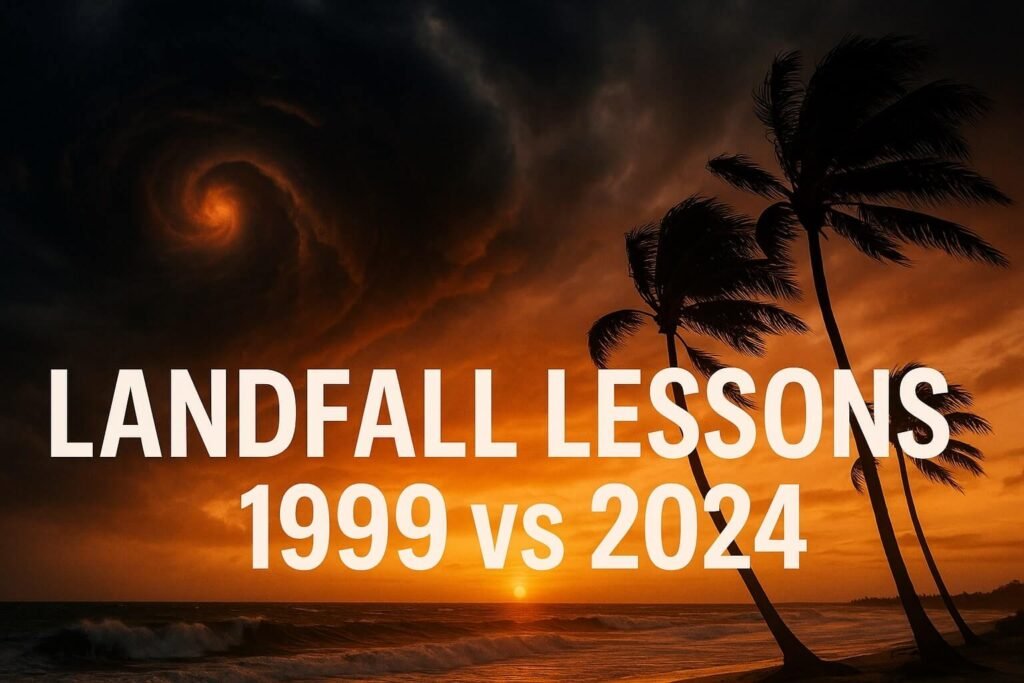In 1999, storms changed communities forever. Huge waves surged inland, buildings crumbled, and thousands lost their lives. Fast forward to 2024, we still faced monstrous storms—but thanks to better preparation and tech, the impact on human life was dramatically reduced. So, what have we learned from comparing the storms of these two pivotal years?
Storm Snapshots: Then vs. Now
1999: Hard Lessons Learned
- Odisha Super Cyclone: Struck India with Category-5 winds. Nearly 10,000 people lost their lives, and entire towns were destroyed.
- Hurricane Floyd: Hit North Carolina causing severe floods, claiming 57 lives, and racking up billions in damage.
2024: Preparedness Pays Off
- Hurricane Helene: Devastated Florida’s Big Bend with Category-4 winds and massive storm surge. Despite severe damage ($78 billion!), early warnings kept fatalities at 251—a fraction compared to older storms.
- Cyclone Belal: Hit Mauritius and Réunion with powerful winds, yet strict “Purple Alert” systems meant only five lives were tragically lost.
Better Forecasting: Tech Makes the Difference
Forecast accuracy improved dramatically between 1999 and 2024. Back in ’99, storm paths and intensities were often unclear until it was too late. By 2024, we could predict storm paths twice as accurately and give people critical extra days to prepare or evacuate safely.
What made this possible?
- High-resolution satellites and radar tracking.
- Powerful supercomputers running sophisticated forecast models.
- Real-time ocean data to predict storm intensification.
Community Preparedness: Acting Before Impact
Preparation today looks vastly different from the 1999 scenario. For example:
- Odisha, India: Learned harsh lessons from 1999. Now, millions evacuate days ahead of storms, and hundreds of cyclone shelters ensure safety.
- Florida, USA: County-level alerts and detailed surge maps meant most coastal residents evacuated long before Hurricane Helene made landfall.
Human Safety vs. Economic Losses
Interestingly, while the number of fatalities per storm has dramatically decreased, the financial cost of storms continues to skyrocket. This shows that even though we’re saving lives, there’s still work to be done to protect homes, businesses, and infrastructure against increasingly severe storms.
Climate Change: The Fuel for Stronger Storms
Warmer oceans are turbocharging storms, causing rapid intensification where hurricanes quickly jump multiple categories in strength overnight. This means future storms could become more dangerous even faster, making accurate forecasts more crucial than ever.
Key Takeaways for Future Landfalls
- Early Warnings Save Lives: Longer lead times directly lower death tolls.
- Investment in Shelters and Infrastructure: Proven to reduce deaths significantly.
- Economic Exposure Rising: More wealth near coasts means higher potential losses.
- Rapid Intensification is the New Norm: Emergency planning must anticipate storms becoming severe rapidly.
- Modern Communication Tools are Crucial: SMS alerts, social media updates, and digital notifications now save more lives than traditional sirens.
Where We Still Need to Improve
- Enhancing resilience for vulnerable and low-income communities.
- Improving intensity forecasts beyond the current accuracy.
- Continuously adapting building codes and insurance policies to the reality of stronger storms.
Final Thought
While storms will continue to threaten, comparing 1999 to 2024 clearly shows that preparation, early warning, and stronger infrastructure drastically reduce human suffering. Let’s continue learning from each landfall to ensure we’re always ready for the next big storm.


